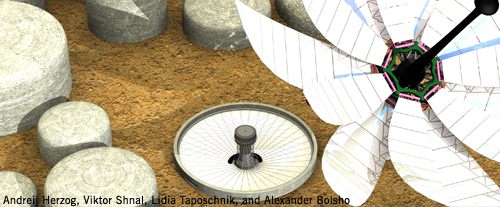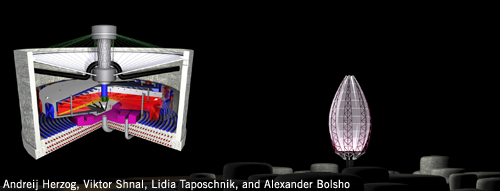Andreij Herzog, Viktor Shnal, Lidia Taposchnik, and Alexander Bolsho
Designed for Site #1 in Dubai, near Ras al Khor Wildlife Sanctuary.

Design Submission for the 2010 Land Art Generator Initiative Design Competition
Artist’s descriptive text:
There is a dream of an oasis, a missing paradise in the desert. It is a green paradise where it gives much clean drinking water. This installation tries to let this paradise come true.
Lotus Flower is a symbol for intact environment and clean water. It is the main element of this installation. The feature of this aquatic plant to stretch its flowers to the sun is here translated directly as a solar mirror.

The solid concrete elements in the immediate surroundings of the solar mirror are very different in their volume. They represent stones of a river and refer to a part of her function: the production of freshwater. In addition, they show the growing meaning of improved storage media as a whole.
It is a risk and a challenge to the imagination to relocate an aquatic plant to the desert. Nature gives us sufficient incentives to this. In this installation these incentives are used. The task of art is creating sensory and intellectual contrasts anyway. These shall show us nature’s core, her mutability.

Electricity generation of the system guarantees a closed turbine with lava jets. The body of the turbine is the core of a generator at the same time. Drive is here caused by heating and cooling of a special fluid. The circulation of the liquid and the rotating turbine produce electricity.

A latent concrete storage serves for the recording of the solar energy below the turbine as well as reconciles concrete tanks at the surface.
Unlike other systems in which water is heated up to transform its thermal energy into power, the Lotus Flower uses thermal energy for the cooling and capture of the available saltwater.
This water at the condensation process in the turbine will be heated first to produce electricity and then cooled down to circulate through the system again.
The humidity from the hot air is obtained in the form of freshwater during the cooling process. So the system uses the surplus energy for the production of freshwater.
[…] cooling process. So the system uses the surplus energy for the production of freshwater. Source: Land Art Generator Initiative Reageer […]